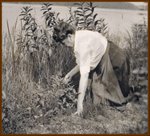I read somewhere that gardeners tend to say, "You should have seen the garden last week." Or else they say, "Oh, the garden will look so much better next week when (this or that) blooms." I vowed not to fall into this trap, but just enjoy the garden as it is in the moment.
All this by way of introduction to our second Annual Wildflower and Garden Brunch last Saturday. I didn't say either of the above statements, but I sure thought them. In the garden the tulips, daffodils and other spring bulbs have wilted; in the woods, the
Dutchmen's breeches, trout lily and
toothwort blooms are gone. In the garden, there were fat buds on the wisteria, bluebells, columbine; in the woods, there were fat buds on
camassia lily.
So Ed and I smiled and looked at what was there. In the garden, primroses, trillium, lilies of the valley and wild oats were the stars. In the woods, the trillium were breathtaking joined by marsh marigolds, rue anemone, ragwort and various violets.
I was even able to put together bouquets for 9 tables from what I thought was a meager source. It is amazing what you see if you look closely.














